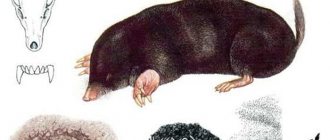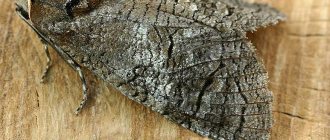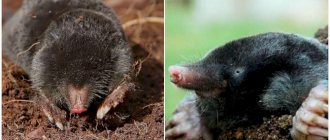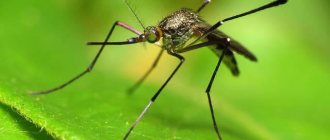Moles in the garden are a fairly common occurrence. And this is not surprising, since moles lead an underground lifestyle, feeding on various bugs and worms that live deep in the earth. These animals move quickly in the thickness of the earth, choosing looser and more fertile soil, in which there is always something to find for food.
Due to the fact that the mole digs peculiar labyrinths underground, it damages the roots of various plants, and also leaves visible furrows on the surface of the earth, which do not look very pleasant, since they can pass through the plantings of various crops. Therefore, the question immediately arises of how to get rid of this animal, despite the fact that it is still a useful animal under certain conditions. In fact, it is not so easy to get rid of it, although sometimes it leaves the area on its own and moves to another. Due to the fact that the mole is underground and it is difficult to calculate its location, there are not many means of combating it. To choose the most suitable method, you should familiarize yourself with some of them.
What is special about moles?
To begin with, you should study their lifestyle well so that the fight against them has a positive effect. The mole belongs to the class of mammals that eats various insects. It can grow up to 20 cm in length. It lives underground and moves by digging underground passages. It is distinguished by its body covered with velvety fur, which is considered the most valuable. The villi grow at right angles, so the mole can move in any direction without any problems. The color of the animal can be dark gray or black. The tarsi are short but well developed, with a spade-shaped extension at the ends. Thanks to this feature, moles dig fairly long tunnels without any problems. They have almost no vision, but their sense of smell is highly developed, thanks to which the mole easily finds food for itself in the thickness of the earth.
The nest of an underground animal is designed in such a way that there is one circular passage at the bottom, and a second, narrower passage at the top. Between the upper and lower passages there is a nest, which is lined with soft substances (plants). The outer passage is connected by 10 tunnels, 6 of which go to the upper passage, and 3 are directed directly to the nest. Here, in the nest, the female gives birth to 3 to 6 cubs. The animals are born from April to June. Under favorable conditions in the month of August, the female can again give birth to moles. Pregnancy lasts about one and a half months.
Moles mainly eat bugs, worms, woodlice, frogs, lizards and even snakes. Thanks to their unique hearing and sense of smell, moles easily find food for themselves. Vision is practically absent, but it helps him navigate the surface of the earth. In winter, moles do not sleep, but dig tunnels for themselves at much greater depths.
Purpose
A mole spends its entire life in a hole. Horizontal and vertical labyrinths are located at different depths. The tunnels intersect with each other and have many exits and entrances. Nora looks confused.
The depth of a mole's hole reaches 2 m. How wide the tunnels are can be judged by the number of tubercles above the ground.
- Tunnels for searching for food are placed approximately 15 cm below the soil surface. The animal feeds on earthworms, bugs, roots, plant seeds, root vegetables, and grain.
- The bedroom is located at a distance of 50 cm from the ground surface. It is small in size, covered with straw, grass, and various twigs. By winter, the animal moves to a room that is located at a depth of at least 1 m.
- Deepest of all are the storerooms where the mole stores supplies. Despite its small size, the animal has a brutal appetite. During the day, he eats an amount of food equal to his total weight.
The photo of the mole hole is located below, where you can see numerous tunnels, passages, exits, storage rooms and sleeping places. The mink protects from attacks by enemies, unfavorable external conditions, and ensures normal life functions of the animal.
Mole hole underground
The benefits and harms of moles
Moles, if they carry out their life activities in natural conditions, are extremely beneficial, since they are not able to harm nature, although they cannot do without the death of individual plants. They make the soil looser, and also raise layers rich in humus closer to the surface. The remains of plants that are on the ground find themselves in more favorable conditions for conversion into humus. Thanks to the presence of mole holes in the ground, the soil is saturated with oxygen and drainage is also improved.
Naturally, when digging their holes, moles damage the root system of plants. If these are natural plants, then you should not expect negative consequences from this, but if these are cultivated plants planted in the garden, then the mole can cause significant harm. From its vital activity, you can lose part of the harvest, and the furrows from the passages spoil the overall landscape.
Mole and vegetable garden
People involved in agriculture often complain about animals. The fact is that mole rats often settle next to areas cultivated by humans. Considering how much he can “steal” from the garden, some are starting to worry. It must be said that the negative attitude towards moles is not entirely justified.
We suggest you read: Blisters on the body itch like bites: acne treatment, what to do
Well, let them eat some potatoes or carrots. At the same time, they also diversify their diet with larvae and other parasites, which can spoil much more of the harvest. This conclusion was reached by experts who found out how a mole digs a hole. This very first floor is intended for feeding. Where the animal lays it, no parasites remain.
How to determine that there are moles on the site
Moles are not the only animals that dig holes in the ground. Mice and gophers do this, but it is not at all difficult to distinguish the life activities of one from the other. You can identify them by the results of their “work,” which are earthen mounds up to 10 cm high if a mole is working underground. In addition, this mound can move, growing in height, which indicates the active phase of its life. In gophers, such mounds have the shape of a horseshoe, and mice dig holes almost at the very surface and their width is about 5 cm. These holes are especially noticeable in the spring, when the snow has melted. In addition, mice feed on the roots and stems of plants, while the mole feeds exclusively on animal food and does not leave such barbaric traces behind.
The most effective way to fight moles.
Burrow length
People, considering the performance achieved by this small builder, focus on the depth of the structure. But there is a more interesting factor that may capture the imagination. Agree, many people can bury themselves four meters into the ground in a straight line. But building tunnels whose length is many times greater than your size is a huge job.
So, this figure can reach up to three hundred and sixty meters (for a mole rat). And it is still unknown whether this is a record. The fact is that many species of moles have not been thoroughly studied. Science knows only general information about them. No one measured the length and depth of their holes. These include, for example, shrews.
Effective ways and methods of controlling moles
If moles have settled in the garden, then getting rid of them is not so easy. Often no control methods work, and you have to literally hunt down the moles. Some manage to get rid of it quickly, while others spend quite a long time trying to do it. To combat moles, you can use one of the methods. For example:
- Scare them away by driving them out of the area.
- Use baited traps.
- Hunt and catch with your hands.
- Use mole beaters.
Moles can settle on the site as a whole family. As a result, they can dig many holes, causing serious damage to the crop. Therefore, the fight against moles must begin immediately after their appearance.
How and with what to scare off moles
Moles have highly developed hearing, so they cannot tolerate loud sounds or extraneous noise. They distract them and prevent them from orienting themselves in space, especially when they need to get food. Therefore, they will immediately try to leave the noisy place. To do this, you can use various rattles or noisemakers. You can either buy them or make them yourself. For production you will need some unnecessary household items, as well as tin cans. You can make them make noise when exposed to wind. Used plastic bottles are perfect for making noisemakers. You don’t need to buy them specially, just go to one of the garbage dumps or go to a nearby forest belt. They are simply left by those who like to relax in nature.
When installing noisemakers or rattles, you should think about your neighbors, as they may not like it. And who will like it if the ratchets work both day and night. If in the country or outside a residential area, then this is the most effective way.
As an alternative, you can use ultrasonic repellers, but they do not provide a complete guarantee, since moles quickly get used to constant sounds of the same frequency. Over time, they begin to avoid dangerous areas.
How to get rid of moles in the garden and the garden
Plants against moles
Most likely, this is a method of control that can be used as a preventive measure, since it cannot be called reliable. The use of plants can be considered as an additional remedy. There are plants that are either poisonous or have such a smell that moles are afraid of it. Such plants can be planted next to beds where cultivated plants grow.
Some plants are considered to repel moles. For example:
- Imperial hazel grouse.
- Narcissus.
- Decorative flowering onion (Allaum).
- Marigold.
- Euphorbia caper.
- Castor bean.
On a note! Euphorbia and castor bean fruits contain toxic components, so planting them on the site if there are children is not recommended.
Poisons and poison
The mole is a predator, so various baits with poisons will be useless. A toxic substance can have an effect if it is dropped directly into a mole hole, but to do this you need to know for sure that moles are moving through it. Moreover, it is better to place the poisonous substance in several places and in several holes, which is not as easy as it seems.
If you decide to use a toxic substance, then first of all you need to think about the consequences, since it will end up in the ground. You can suffer from this poison yourself and harm your plants. No one would want to use such dangerous substances on their property.
Traps and traps
A mole can also be caught using a trap. The most effective is considered to be the Solomon trap, which consists of a piece of metal pipe about 40 cm long. The diameter of the pipe must correspond to the diameter of the hole, or rather, the trap must fit freely into the hole. There should be doors on both sides of the pipe that open only inward. The trap is installed in a hole and covered with earth.
Traps are not considered a humane means of combating moles, although there are designs of traps that do not have this drawback. They are also installed in burrows. But this does not give any guarantee of their capture, since the mole has a unique sense of smell and can easily sense a foreign odor. That he should make another hole nearby. In addition, the trap, which is located in the hole, can be triggered by soil shedding.
Mole or Blind 100% way to catch
Mole beaters
These are devices that use electricity to kill moles. These devices are installed in burrows. When the mole approaches the danger zone, the device is triggered and the mole is killed by an electrical impulse.
How to catch a mole with a shovel
This is the simplest, most accessible and effective method, but first you need to track down the mole. Its activity can be determined by the moving mound of earth. First, you need to carefully approach this hill with a shovel and freeze, waiting for the next activity of the animal. At the same time, the shovel should already be partially stuck into the ground, next to the tubercle. As soon as the tubercle begins to move, the shovel quickly plunges into the ground and the mole is dug out along with the ground. The effectiveness of the fight depends on several factors: caution, attentiveness and speed of movement.
The easiest way to catch moles.
Flooding of holes
Considering the fact that there may be not one hole underground, but several, simply trying to flood the holes with water is not an option and there are no guarantees that the mole will be expelled from the area. If, of course, you insert a hose into the hole and supply water under pressure, then you can get a positive result from this approach. If you throw carbide into the hole, the efficiency will increase significantly. Unfortunately, this is an inhumane method, especially in relation to a useful animal.
Science and moles
Science fiction fans know that the unusual animal was noticed by physicists. Those, in the course of studying the multidimensionality of our world, came to certain conclusions. It turns out that space is nonlinear. It can curl up. And its parts are connected by passages reminiscent of mole holes. It has not yet been possible to take a photo of such a phenomenon.
And it’s difficult to prove its existence. So far, only science fiction writers and some advanced scientists operating on the edge of the official system use the concept of “wormholes.” And it came to the researchers’ minds precisely in view of the secrecy of the lifestyle of this animal. He keeps his secrets from the curious, sometimes not very deeply, and sometimes far from
Try and find his home!
Who are moles
These earth creatures prefer to eat insects instead of your garden plants.
However, their underground tunnels can ruin your garden or lawn and make plants easier for other rodents to access. If you notice a significant increase in the population of moles or other similar pests in your area, this suggests trouble ahead. Moles are usually found in areas where the soil is rich in organic matter. Their presence in excessively large quantities may be associated with a high number of soil pests. Thus, moles are a signal that all is not well with the soil.
These amazing little mammals are similar in appearance to Idaho potatoes. They have a pointed snout, tiny eyes and a small body. When moving underground, they actually swim in the soil, using their broad front paws-flippers to make their way. The animals prefer moist loamy soil and are especially active in the early morning or evening in spring and fall. After warm rain, their small faces can be seen on the surface.
A distinctive feature of moles is their pointed muzzle, which lacks hair. The eyes and ear canals are hidden under the fur, and there are no external ears. Wide front feet with webbed toes and narrow hind feet with thin claws help them move easily underground. Typically, adults reach 17 cm in length and weigh about 1.5 kg.
European mole behavior
The mole screws itself into the ground and scrapes it with its paws, this is how the digging process occurs.
The animal is not capable of gnawing the soil with its incisors, so it chooses only soft, pliable soils for life. Other species of animals (shrew, weasel, ermine) often travel along the deep underground passages of moles. A mole can swim across a small river, so its course, which was interrupted on one bank, continues on the other. On the surface, the mole is clumsy, moves only by crawling, and therefore comes out quite rarely. The track of a mole on the surface of the earth is a furrow with an imprint of the hind limbs on the bottom and the forelimbs on the sides. Moles spend their entire lives underground, where they build entire labyrinths of passages that look like systems of multi-tiered galleries 5-5.5 cm in diameter. The average depth at which the main passages are located is 10-50 cm. The mole has two types of passages: residential and feeding. Transitions from nests to feeding areas and watering holes occur along the residential passages, and feeding passages are traps where invertebrate animals are caught from adjacent layers of soil. Feeding passages are usually located horizontally near the surface (2-5 cm deep). They are visible from the outside, since the ceiling of the passage rises above the ground when it is dug. The nesting chamber is located 1.5-2 m underground, in protected places: between roots, under a stump, hummock, stone, building. It is combined with the stern passages by special inclined passages.
During the night, the mole makes about 50 meters of passages. Since excess earth is thrown to the surface during digging, characteristic piles of earth appear - molehills, through which it is easy to detect the habitats of moles.
The European mole leads an active lifestyle throughout the year. In winter, it makes passages under the snow, where invertebrates gather, or at depths below the soil freezing level. If the winter is very harsh and the ground freezes more than half a meter, then moles often die due to lack of food. Droughts also have an adverse effect on the life of moles. An adult mole is usually attached to its area and returns to it, even if it is kicked out or carried away. During resettlement, the young animal moves away from the mother’s site by about 2 km.
An adult mole is a quarrelsome animal; it attacks relatives who wander into its area and can even kill. Cannibalism is typical. The lifespan of the European mole in nature is 4-5 years.











